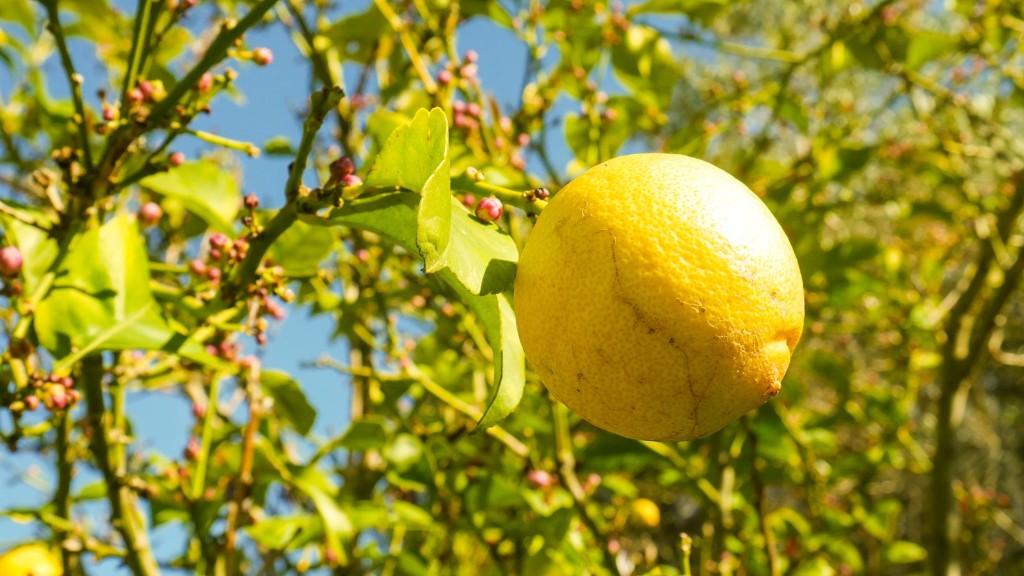What is eating my lemon tree buds? This is a common problem for many home gardeners. If left untreated, certain pests, diseases, and environmental conditions can cause a plant’s buds to be eaten or fail to open. Identifying the cause of this damage and remedying the situation can help protect the lemon tree for the future.
Insects are a common cause of bud damage in lemon trees. Caterpillars, aphids, thrips, whitefly and mole crickets are some of the insects that may be responsible. These pests can cause damage by feeding on the buds, damaging the tissue and preventing the bud from opening. Persistent pest control programs, such as monitoring, pruning, and the use of approved insecticides, can help keep these insects under control.
Fungal and bacterial diseases can also cause bud damage in the lemon tree. Especially in humid or wet climates, diseases such as canker, die-back, and fire blight can reduce the development of flower buds. These diseases can be prevented and treated with the use of fungicides and other chemical treatments, as well as by improving growing conditions and ensuring good hygiene in the orchard.
In some cases, certain environmental conditions may be the cause of bud damage. Hot or cold air temperatures, strong winds, or drought can disrupt the bloom cycle of the lemon tree, or cause the buds to weigh down the stems. In these cases, the solution may be to provide some shade to protect tender buds from the sun or to carefully water the lemon tree during dry periods.
Finally, improper pruning can also damage lemon tree buds. Cut away dead or damaged wood early in the season before the new growth begins. If pruning is necessary during the growing season, cut back only the previous year’s growth and avoid cutting away too much of the current year’s growth.
Signs Of Insect Infestation
If insect infestation is the cause of bud damage in the lemon tree, there are a few signs that can help identify the culprit. Aphids and other small pests leave sticky residue on the buds and leaves while larger pests such as caterpillars can be seen feeding on the buds. In cases of severe infestations, insect eggs may also be visible on the buds or leaves of the tree.
The best way to stop insect damage is to prevent it in the first place. Regularly inspect lemon trees for signs of pest activity and take immediate action when it is spotted. This can include pruning away affected branches, applying insecticides, or introducing beneficial predatory insects to the orchard.
In situations where the infestation cannot be checked in a timely manner, it may be necessary to remove the affected branches or even the whole tree, if necessary. In that case, it is important to make sure that the area is free of any remaining pests before planting a new lemon tree.
Treating Disease
If a disease is the cause of bud damage in the lemon tree, the most important step is to identify the type of disease and take appropriate action. Canker, for example, may require aggressive pruning and chemical treatments to protect healthy branches. Die-back, on the other hand, can be treated by removing all infected branches and using fungicides.
It’s also important to improve the overall growing conditions and hygiene of the orchard. Faulty irrigation systems, poor soil drainage, and overcrowding can create conditions conducive to disease. Remove dead or diseased leaves and branches, prune away weak and dying branches, and maintain a healthy balance of nutrients and water in the soil.
Finally, it is important to take a holistic approach when combating diseases in fruit trees. Crop rotation can help break the cycle of reinfection and ensure that the trees are able to thrive in future seasons. Well-timed pruning can also help by removing diseased branches, improving air flow and allowing more light to reach the lemon tree.
Managing Environmental Conditions
If environmental conditions are the cause of bud damage, there are a few steps that can be taken to help protect the lemon tree and its buds. In cold winter climates, making sure that the lemon tree is well protected from strong winds or snow can help mitigate the effects of cold weather. If the tree is planted in an exposed location, a windbreak or snow fence may be necessary.
In hot climates, providing some shade to protect the buds from the sun can be beneficial. This doesn’t need to be elaborate, simply creating small barriers around the tree can help. Deeper mulches can also help insulate the tree’s roots against heat stress while still allowing air and water to reach the tree.
During dry periods, careful irrigation and mulch can help the lemon tree resist stress. Apply water in the morning to give the tree’s roots time to absorb the moisture before the heat of the day. Organic mulching materials, such as straw, can help buffer the soil against temperature swings and retain moisture.
Finally, pruning away dead or dying branches can be beneficial in reducing the stress on the tree during these periods. Removing dead wood prevents the disease from spreading and allows the remaining plants to direct their energy towards fruiting and flowering.
Pruning For Healthy Buds
Pruning can be an effective tool for ensuring that the lemon tree’s buds remain healthy and open properly. The best time for pruning lemon trees is in the late fall or early winter, when the tree is dormant. During this period, it is important to prune away any dead or diseased branches, as well as any shoots that are out of shape.
When performing pruning during the growing season, it is important to target only the previous year’s growth. Cutting away too much of the current year’s growth can affect the future flowering and fruiting of the lemon tree. Pruning also provides an opportunity to thin out overly crowded plants, improving air circulation and light penetration.
It is also important to use proper pruning techniques when dealing with citrus trees. Avoid creating flat tops or unnatural shape, as this can reduce the plant’s vigor and decrease its ability to develop healthy buds. Instead, use thinning cuts to remove unnecessary dead wood and open up crowded areas.
Finally, make sure that the tools used for pruning are clean and sharp. Dull or improperly cared for tools can cause injuries to the plant and create a favorable environment for disease. Disinfect tools between each cut and replace any that are worn or excessively rusty.



